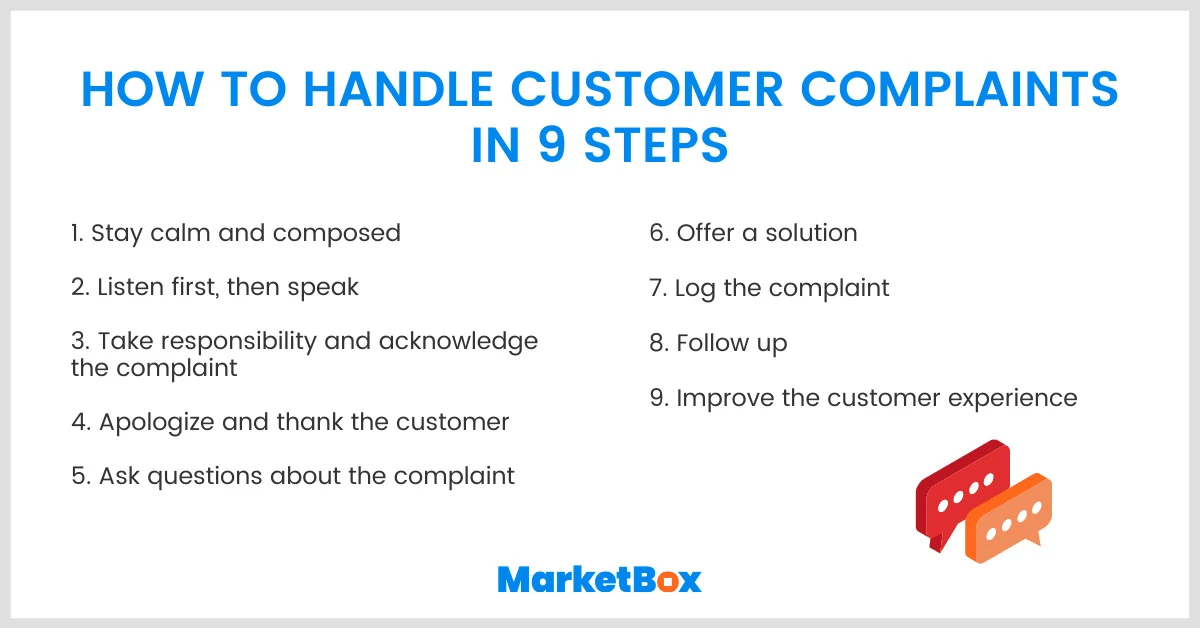How to Handle Customer Complaints About Your Service Business
Learn how to handle customer complaints effectively and keep customers happy.

Skip to
- how to respond to customer complaints
- customer complaint response template
- tips on how to respond to customer complaints
Responding to customer complaints isn’t just about addressing grievances; it’s about something much larger — the customer experience.
How you handle customer complaints online or in person impacts customers’ perceptions of your service business and can be the difference between retaining their business and not. It can also impact your ability to attract new customers.
Reports suggest that Americans will tell 15 people about a bad customer service experience — that’s not the kind of customer referral you want!
Avoid costly mistakes and correctly handle customer complaints about your service business with this short guide.
How to respond to customer complaints in 9 Steps

Step 1. Stay calm when handling customer complaints
Your natural reaction to receiving a customer service complaint may be to get defensive. But it’s important to remember it’s not a personal attack on you or your business but on the situation the customer experienced.
Rather than getting confrontational and letting your emotions get the better of you, remain calm. Remember, you’re representing your service business, so how you respond to a complaint speaks volumes.
Step 2. Actively listen to customer complaints
If a customer has gone to the effort of logging a complaint, it’s because they’re looking for a resolution. Your customers want to feel heard and know they’re a priority, so actively listening to their complaints is so important.
It seems simple, but it can be easy to brush off the situation as a one-off or the customer overreacting when responding to a customer complaint. As a result, you don’t spend enough time listening to the details or understanding why it was such an issue for them.
If you’ve received a bad review online, contact the customer to learn more about the situation. This lets the customer know you care since you’re taking time to understand and address how they’re feeling. As your customer explains, be empathetic and listen more than you speak.
Tip: Call or email the customer first. Always wait to reply to a bad review until after the situation is resolved, so you can outline to anyone reading it the steps taken to resolve the issue so they know it won’t happen to them too.
Step 3. Take responsibility and acknowledge customer service complaints

One of the worst things you can do when a customer has a complaint is to make excuses. In these situations, it doesn’t matter what the “real reason” is; it’s enough that it happened in the first place.
To effectively respond to customer complaints and maintain good relationships with clients, taking responsibility for the situation is important. Whether they’re upset about a specific employee or one of your policies, do your best to acknowledge the customer’s complaint. And whatever you do, never blame the customer!
Of course, if the complaint is about something outside your control, politely explain the situation and offer them a discount on their next booking. Even if it’s not something you technically need to apologize for, a little goodwill can go a long way to earning repeat business after a bad experience.
Step 4. Apologize and thank the Customer for bringing their concern to your attention
Some customers are just looking for an apology, a verbal acknowledgment of their frustration, so don’t be afraid to offer them one.
According to the Nottingham School of Economics, unhappy customers are willing to forgive companies more if an apology is offered rather than just being compensated.
Be warned, though: you’ve got to make it sincere!
Step 5. Don’t be afraid to ask questions about the complaint
When you receive a customer complaint, the more details you have, the better. After all, how can you get to the root of the complaint if you don’t have the full picture?
If it’s unclear in the initial customer complaint, ask open-ended questions to understand the issue better. Examples include
- What do you mean by that?
- Could you provide an example?
- Could you expand on that a little further, please?
To ensure there is no miscommunication — and to show the customer you’re listening — don’t be afraid to reiterate what they’ve said, using language such as
- To be clear, this is what happened…
- If I understand correctly…
- I just want to clarify some details…
Tip: Be aware of your tone when asking questions or reiterating. The last thing you want is to come across as rude or confrontational!
Step 6. Offer a solution to the customer service complaint

When it comes to resolving customer complaints, it’s not enough to just apologize; you’ve got to present a solution.
Alongside taking steps to remedy the issue, consider one of the following:
- Providing a gift card or discount on a future service
- Redoing the work to their satisfaction
- A partial or full refund depending on the severity of the issue
It can also be helpful to tell the customer what steps you’ve taken to ensure this doesn’t happen again, e.g., providing additional training to employees, improving your scheduling practices, etc.
Keep in mind that the solution offered should be within your service business’s guidelines. You don’t want to make promises you can’t commit to; that’ll only make things worse!
Example of an effective customer complaint response
Problem: You own a beauty salon and a customer isn’t happy with their manicure from one of your staff.
Solution: Offer to redo the manicure free of charge or provide a discount on a future manicure with another service provider.
Step 7. Log the customer service complaint
Keep a detailed record of all customer service complaints and the steps you took to address them using a spreadsheet or software like Jira.
Review these records regularly and use the data to identify potential service weaknesses, so you can continue to improve your customer experience and service quality.
Step 8. Follow-up on the customer complaint
According to Forum Corporation, 70% of customers churn because of poor customer service. One way to reduce this (especially after a customer complaint) is to follow up with customers.
Something as simple as an email is often enough to show customers you care.
Step 9. Improve the customer experience

No company is perfect, and it’s ok if your service business gets customer complaints occasionally. It’s what you do with this customer feedback that matters.
Every customer complaint is an opportunity to make improvements to your business and improve your customer service. But to avoid customer complaints in the first place, you must take a proactive approach to improve your customer experience.
Review your practices regularly, and use customer feedback, surveys, and sales metrics to identify areas to improve. Invest in regular training for your team, and implement software to make it easier for customers to transact with your business.
However, if your service business is getting customer complaints regularly, this is a sign of something bigger going on, and you need to act quickly to find out what’s happening and how you can fix it.
Customer complaint response template
Hi [customer first name],
Thank you for bringing this to my attention; I’m very sorry you had this experience. We always strive to provide a high-quality service to our customers, and unfortunately, in this case, we missed the mark.
I apologize that we failed you this time by [re-state the customer complaint]. I looked into this for you, and it was likely a result of [brief explanation — no excuses], but regardless, it should not have happened.
I have passed your feedback on to my team and assure you that we are actively taking steps to ensure this doesn’t happen again. (Optional — In response to your feedback, we are [additional steps taken].)
I would like to apologize again for the inconvenience this caused and offer you [resolution/compensation].
If you need further assistance, please let me know. We look forward to seeing you again soon.
Many thanks,
[Your name]
Example of the template in action in response to a mobile nail tech that arrived late for an appointment:
Hi Kelly,
Thank you for bringing this to my attention; I’m very sorry you had this experience. We always strive to provide a high-quality service to our customers, and unfortunately, in this case, we missed the mark.
I apologize that we failed you this time by running 20 minutes late to your appointment. I have looked into this for you, and it was likely a result of a scheduling oversight, but regardless, it should not have happened.
I have passed your feedback on to my team and assure you that we are actively taking steps to ensure this doesn’t happen again. In response to your feedback, I have reviewed our scheduling process and increased the travel time allowance for our in-home appointments.
I would like to apologize again for the inconvenience this caused and offer you 50% off your next manicure.
If you need further assistance, please let me know. We look forward to seeing you again soon.
Many thanks,
Jane, owner of Nails4U
Tips on how to respond to customer complaints
Tip #1- Create a customer complaint handling procedure
The best way to handle customer complaints is to have a procedure in place for when they do happen.
Developing a customer complaint process may take some upfront work, but it will benefit your service business in the long run if all employees are on the same page.
As you develop your customer complaint handling procedure, consider the following:
- Ensure the procedure guides your team through specific response strategies
- Keep the emphasis on high-quality service
- Provide your team with ways to troubleshoot complaints before they become bigger issues
- Assign a team member to respond to customer reviews online regularly
We recommend asking these guiding questions when developing a complaint procedure:
- When customer complaints arise, what kinds of solutions will you offer to the customer?
- Which team member(s) will handle the complaint? What is the chain of escalation?
- Is there a way to address the issue before the customer leaves a bad review online?
Regularly document and review the procedures during staff onboarding and training sessions to keep your process up-to-date.
Why it’s important to have a customer complaint procedure
What customers say about your service business matters. This is why being equipped to handle customer complaints is critical to improving online business ratings.
Smart handling of customer complaints will also give you a leg up; when potential customers search for services online, they won’t be turned off and choose a competitor over you.
Tip #2- Stay on the same team as your customers
We all know it costs more to acquire a new customer than to retain an existing one, so before burning bridges, take a deep breath and think carefully about your response.
After all, if the customer is agitated, what good will challenging their complaint do?
Stay calm, listen, take responsibility, apologize, and focus on working together to find a solution.
Tip #3- Move on from the customer service complaint
Our last tip on how to deal with customer complaints is to stay positive!
It’s easy to let a negative experience ruin your day, but once you’ve dealt with a customer complaint, learn from it and move on. To help with this, it’s good practice to keep a record of positive customer interactions.
Platforms like MarketBox enable customers to leave reviews at the end of service experiences, which you can leverage to track positive interactions. That way, when customer complaints do happen, you’ve got a nice reminder that they’re in the minority and you’re still doing well!
Final thoughts
Handling customer complaints can be tough. It requires a lot of patience to deal with upset customers, especially if their complaints are unfounded. But it’s important to remember that your response affects your service business long after the customer has calmed down.
Having a customer complaint procedure will give you and your service providers a systematic way of handling complaints, and by following the nine steps above, you’ll be ready to handle customer complaints as and when they arise.
Ready to transform your scheduling?
Talk to our sales team and see how MarketBox can help you achieve more with less effort




.svg)

